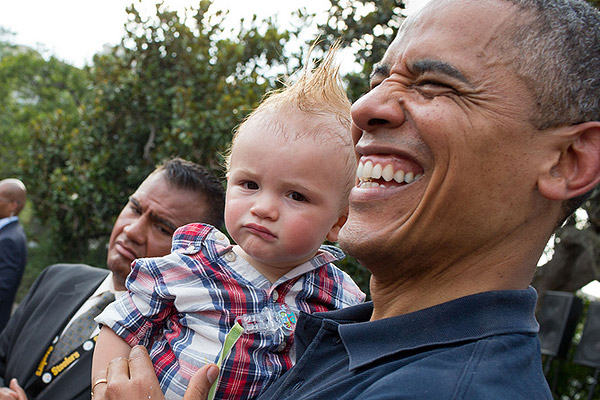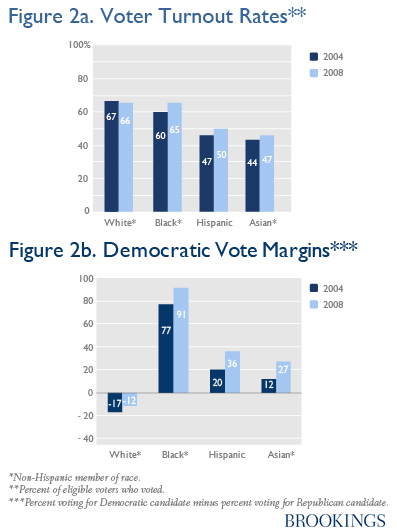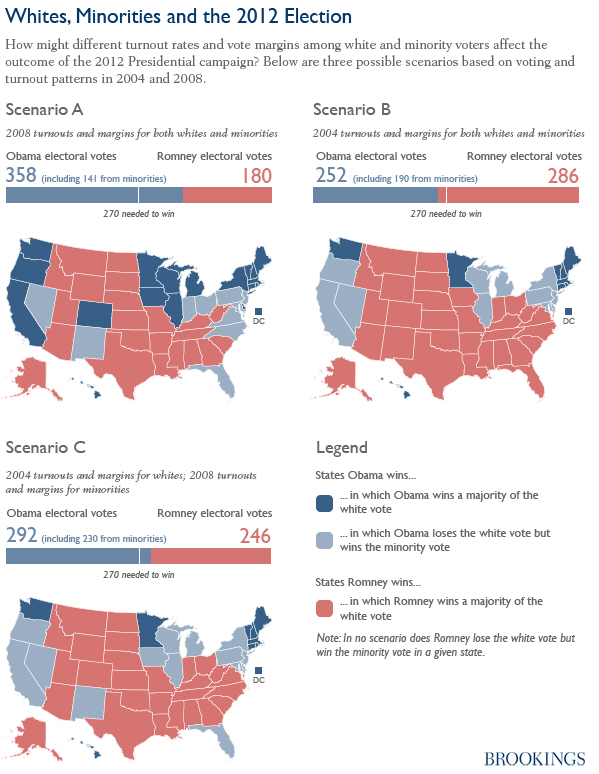
Update: Like I was saying.
With two and a half candidate-shopping months left 'til election day, Barack Obama's doing pretty well. Nate Silver currently has him winning 300.6 electoral votes to Mitt Romney's 237.4, with a 70.7 percent chance of winning (though it's dropped 1.3 percent over the past week). The electoral vote projections are even friendlier to Obama, with all the reasonably high projections centering around 330 electoral votes. Which sounds good, but it's not much of a landslide—300 electoral votes would be 14 more than Bush got against Kerry, but 65 less than Obama got against John McCain.
Jamelle Bouie, a blogger I like a lot, argues that, following the pick of Paul Ryan, we should expect "the coming Obama landslide." His reasoning is compelling, but I think he's being overconfident:
In terms of demographics, Mitt Romney has one path to victory: overwhelming support from white voters. At the least, he’ll have to outperform every Republican since Ronald Reagan, and win 60 percent of their votes. And this is if minority turnout is at its 2008 levels. If it increases, he needs even more whites to make up the difference.
Seniors play a key part in this coalition. The New Republic’s Nate Cohn puts it bluntly: “Romney’s road to the White House runs through seniors.” John McCain won 51 percent of seniors, beating Obama by four percentage points. At the moment, Cohn notes, Obama’s support among this group is in the low 40s. If the former Massachusetts governor can outperform McCain and crush Obama among older Americans, he can eke out a narrow win. But if Obama can hold his own—and move closer to his 2008 total—he’ll have secured victory.
In short, if we get the Old Glory Insurance Campaign that all indications suggest, Mediscare 2012 will sink Romney with old people (which is why Romney is running his own ads on Obamacare and Medicare). And Ryan's budget is the leverage.
But: "this is if minority turnout is at its 2008 levels. If it increases, he needs even more whites to make up the difference." Minority turnout was really high in 2008, and white turnout was low:
"The overall message is total ballots cast by white Americans was down, while African Americans and Latinos cast way more ballots than they did in 2004," said Jody Herman, a researcher with Project Vote. "And young voters, age 18-29, cast over 1.8 million more ballots than in 2005, which is a 9 percent increase. That increase was greater than any other age group."
[snip]
Still, the preliminary research by Project Vote, which organized registration drives in two dozen states in 2008, was striking. It found 1.18 million fewer whites voted on November 4 compared to November 2004.
In contrast, 2.88 million more African Americans, 1.52 million more Latinos, 67,000 more Asian Americans and 1.32 million members of other minorities, voted this fall compared to four years ago. That is 1.18 million fewer white voters and 6.96 million more minority voters.
And there are reasons for this: the first black presidential candidate (in the general election, at least), a comparatively young candidate with a biography that appealed to liberals, an electorate weary of the GWB administration and the Republican establishment more generally but not yet re-energized by the Tea Party.
Now the bloom is off the rose for Obama—liberals have found reasons to still like him, but also lots of reasons not to. My instinct is that both minority and white votes will regress; there may be a new plateau, but I don't think it's exactly 2008 levels, and it's unlikely that it's higher. Demographic changes favor Obama, but I don't know that it's enough to offset a second-term run after a difficult first term, and the polling and forecasts seem to reflect that.
The other issue to consider is voting laws in swing states. Take Ohio:
Ohio doesn’t treat all voters the same. Depending on where you live, your polling place may close promptly 5 p.m., or stay open in the evenings and on weekends. More specifically, if you live in a county likely to favor President Obama, you’ll have to get to the polls before the end of the traditional work day; if you live in a county likely to swing Republican, you can take your time.
After immense pressure, Ohio's secretary of state has said he'll establish uniform voting hours, but it hasn't happened yet. And it's not the only voting issue in Ohio. The Obama campaign has filed suit against the state for cutting early voting for all but Ohioans overseas and active military members.
Nate Silver predicts that Ohio is the most likely state to provide the decisive electoral vote: almost a 30 percent chance. Wisconsin is the fourth-most-likely state; it's embroiled in a voter ID controversy, though after two court defeats it probably won't take effect in 2012. Pennsylvania is fifth, and its voter ID law hasn't been blocked, despite greater controversy:
About a week ago, Republican Mike Turzai, Pennsylvania's House Majority Leader, made a startling confession. Boasting about the state's new voter-ID law, which was ostensibly about the integrity of the electoral process, Turzai bragged that the law "is gonna allow Governor Romney to win the state of Pennsylvania."
Implementation has also been a mess, with the state scrambling to figure out how many voters it will effect.
Bouie's absolutely right to focus on minority and senior turnout, I'm just unsure they will break in the way he thinks. A Brookings report puts it in perspective:


My guess is that the most likely scenario is somewhere between B and C—an extremely tight race.
Photograph: The White House



